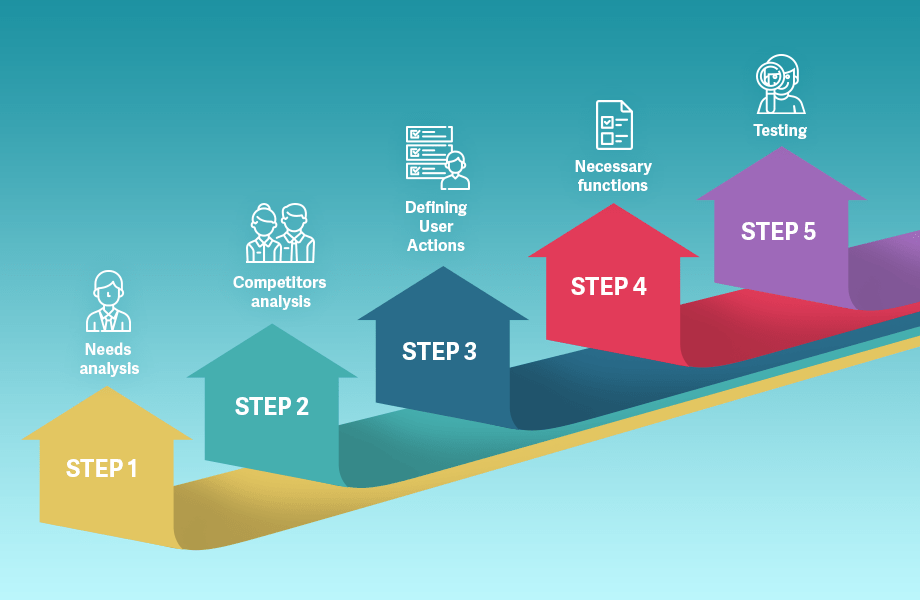By: Evgeniya Vi.
23 FEB 2018
6016
Let’s talk about a minimum viable product (MVP). If you have an idea for an excellent service or application that solves a problem for users, do not rush to invest in the development of a full-featured product and spend months of painstaking work preparing behind closed doors. According to the concept of a “lean startup,” it will be much more effective if you can find the answer to the question “Is this product necessary for users?” That answer will tell you why your startup needs MVP.
What Is MVP?
A minimum viable product, sometimes mistakenly deciphered as a minimal valuable product or a minimum valuable product. MVP is a minimally viable product that allows you to get meaningful feedback from users, to understand what they need, and then to not create something that they are not interested in and which they are not ready to use & to pay for.
Within the framework of this concept, the idea of your startup is the hypothesis. To test it, you need to do the following:
- Clearly formulate a hypothesis.
- Define the criteria by which its viability will be determined.
- Make a minimally viable product to confirm the hypothesis, and then run it.
- Measure performance indicators.
- Draw conclusions, and test the following hypothesis, if necessary.
MVP for startups does not in any way mean a raw product made in a hurry. MVP development simply spends minimal time on the product, and it contains only key functions, the relevance of which should be tested for real users. Over 60% of the features are not used at all and therefore are not in demand among users. The MVP concept allows you to shorten the startup time of the project by creating only the necessary functions and to begin to receive real feedback for your product.
In this case, the process does not end with receiving feedback. The methodology of a lean startup, to which the MVP concept belongs, is based on the development–measurement–study feedback cycle. Therefore, it is necessary to finalize the successful features and retest them after receiving the feedback. If successful, you can create a fully-fledged product and enter the market.
Why Does a Startup Need MVP?
No matter how good an idea is, the idea is not the end result. By creating a minimally viable product, you can:
- Save money without investing in a failed project.
- Check if your product interests potential users.
- Use iterations to find out which direction of development will be most optimal.
- Develop a base of potential customers and find early adopters of your product.
Steve Blank, the author of the customer development methodology, argues that the main reason for the failure of projects that are otherwise successful in many respects is their clients’ lack of knowledge. Instead of studying their needs in the early stages and developing the MVP product, the founders’ startups head straight out to the public on a risky venture, untested on real users.
Examples of Successful Projects That Started Their Journey with MVP
Spotify: Only one function was asked of MVP—streaming music. Today, this project, with more than 60 million users, is worth more than 8.4 billion dollars.
Foursquare: The MVP company Foursquare used check-ins and awards for users in the form of badges. After studying the users’ reactions, the MVP developers began to expand its capabilities, adding recommendations & city guides. Today, the service brings together 50 million people who have been checked-in 8 billion times.
Groupon: Before testing the idea of a collective link service, the creators of Groupon made website The Point, which was designed to ensure that people who cannot accomplish something alone can find like-minded people to help them accomplish it. However, the idea turned out to be too general, so they launched a customized blog on the Wordpress platform, where information was added manually only about the possibilities of collective discounts. When users subscribed to a certain discount, a PDF file with information about it was sent to them via email using Apple Mail. Thus, the founders of Groupon were able to test their hypothesis (people are interested in collective discounts) with minimal costs.
Uber: This project was implemented only for the audience in San Francisco and allowed mobile users to communicate with taxi drivers and pay for their trip. Only after they received the correct feedback did they add other elements to improve the application.
How to Create MVP for a Successful Startup
If we do not know who our client is, we do not know what quality is. ...The ability to learn faster from customers is the most important competitive advantage required by any start-up.
Step 1: Needs Analysis—Determine Which Problem You Are Solving and for Whom
It is necessary to solve the problems customers actually have. This is called finding pain points, that is, the needs or wants of the users. The application must solve at least one problem for your target users or target audience. Take Uber, for example. The problem for drivers is that there are no passengers; the problem for customers is that there is no car. Boom! Uber came in and solved these problems at the same time; this is the secret to success. Of course, your startup will not initially be as global as Uber is now, but after all, Uber only started with San Francisco, and look how far it has come.
The first thing you need to do is evaluate the business idea. Try to think like your user, and answer questions like why you need this project and how it can help you. This is the formation of your goal in addition to determining your target users.
Step 2: Analysis of Competitors
It is necessary to stand out in the market. Find out what your competitors are missing. Look for something special about your startup that will make people prefer you over someone else.
Sometimes entrepreneurs ignore analyzing their competitors because of their pure belief in the uniqueness of their product. Keep in mind that even if you do not think that you have direct competitors, your belief in the uniqueness of your product is not a sufficient reason for confident promotion of your product on the market without first testing the idea out.
There are many tools that will help you analyze your competitors using different parameters, for example, SimilarWeb, App Annie, MOZ, Ahrefs, SensorTower, and QuantCast, among others. It will be useful to conduct an analysis of user feedback on the products of your competitors. This will help you to take into account any of their shortcomings and to create an MVP for your product based on user experience.
Step 3: Defining User Actions
To determine the main flow of user activity, you need to first focus on the product’s goals and its main tasks. For example, if your product is an online cosmetics store, the main tasks that the user wants to solve are “find cosmetics,” “buy cosmetics,” “manage orders,” “track delivery,” and “receive an order.” When you have correctly defined these goals and objectives, you can then progress to specific functions for each phase of product use.
Step 4: Necessary Functions’ Determining and Careful Planning
At this stage, you can start creating a list of functions for each step. In this case, it is necessary to identify the main functions as well as the secondary ones. After that, define your priorities:
- The main function should correspond to the most important action that should be performed by users of your application.
- Select additional functions that you plan to offer to users within the application; explain why they are needed, and then delete the least important ones.
- Classify all functions according to the principles of “must have,” “nice to have” and “do not care.” To do this, you can build a matrix, where the stages of the process are displayed horizontally and the functions corresponding to the processes that you can later build by priority are displayed vertically.
- Define the functions for the first version of the product.
When approaching the development, you should have clear answers to the following questions:
- Which of these features guarantee a focus on target users?
- What features of the product must be included in MVP, and which ones should be saved for the full release?
- Which will help you not just stand out but even surpass your competitors?
Remember that the most important goal of your product at any stage of its development should be a solution to the “pain” of the customer or user. Only then will there be a demand for your product and its ultimate success.
Step 5: Flexible MVP Development
MVP development does not usually take as long as it takes to create a fully fledged product, but this process has its own nuances:
- Cyclicity and analysis: Due to the fact that MVP is created in order to understand whether a user needs your product, the process of its development is cyclical: the idea - the prototype - the demand estimation - the information gathering - the error analysis - the improvement - the repetition. Therefore, MVP, if demand met expectations, exists until it is improved so much that it can be called the most viable product and users are satisfied with it.
- Flexible methodology: Developing MVP using traditional methodologies such as Waterfall will knowingly doom your project to failure. After all, their main principle is linearity, the fulfillment of consecutive tasks, without the possibility of a rollback to the previous task. MVP also requires a constant return to the beginning for fixing any detected errors or deficiencies. The best option is Agile’s flexible methodologies, such as Scrum. This is the methodology that is used to create the MVP in Appus Studio.
A completed MVP can be considered successful only when it is a high-quality and it is created with minimum number of functions.
Step 6: Testing
After development, the product must be tested. Experts do this first, and they determine the product’s readiness in A / B testing. Beta testing is what gives you a real picture of how users are perceiving your product. On average, this process can take one to two weeks. Feedback from users will be a guide for changes, improvements, and modifications. Only real users can determine what functions are missing and which ones are superfluous.
The Most Common Mistakes in MVP Development
The following mistakes can result in the failure of your idea:
The Desire to Do Everything All at Once
Remember the main idea of MVP, and implement only the key functions. Use the MVP to provide customers with a common understanding of the future product.
If the product is not needed, neither good design nor fast performance will save it, and resources will already have been spent.
Important: Do not try to cover all platforms at once if the startup is a mobile application. Concentrate on firmware and basic functions for iOS before implementing the same for Android.
Saving on the Implementation of Basic Functions
The fact that we do not waste resources on unnecessary functionality does not mean that we are saving resources in every area.
Key functions are done at the highest quality possible. If you decide to make an MVP site on a free hosting site, you will lose. It is important to show customers key functions as well as their quality. In the case of the MVP site, it is better to have a simple but reliable and customizable web page than a free one that takes a long time to load.
Important: Minimum does not mean “unfinished” or “minimal quality.”
Neglecting the Cupcake Principle
The MVP should be a fully fledged product with a specific function. Throughout the period of product introduction, customers should enjoy its “light version.”
No automobile manufacturer brings to the market first a wheel, then a wheel and a body, and so on. Each time a fully fledged product is issued it is ready for use, customer loyalty is then evaluated, and then functionality is added.
The final product is the sum of previous successful MVP implementations.
This is called the cupcake principle. Before creating a huge multi-layer cake, we offer our guests a cupcake. A cupcake is a full-fledged product, according to what we can see, do our users like our product or they do not.
Ignoring Users’ Feedback
Many startups fail because of the fact that they ignored the feedback they received from users and testers.
Make sure you react to the feedback you receive from them and eliminate any shortcomings. If customers say that everything works smoothly, then bring the product up to the standard of perfection.
Important indicators:
- Daily number of users
- Retention factors
- Average time spent in the application or on the website
Use analytics tools to get this information.
Announcing Some of the Functions without Their Subsequent Implementation
It’s good when the service has its own unique feature. Customers can come to you precisely because of it.
In the MVP phase, startups often like to announce future innovations and additions.
But things change, and before these additions can take place, changes have been made and plans have changed. Do not lie to your customers for marketing purposes or for any other reason.
If you have disappointed your users, have the courage to make a public apology.
Important: your reputation is everything.
Only the Idea Matters
Sometimes obsession with the success of a business idea prevents you from objectively assessing how everything is actually going. Yes, your baby is very dear to you, but it is not an idol to blindly worship.
Important: If testing shows that it would be best to remove some element, do not fight it.
Save that idea for a future project.
A Copy of Existing Products
Startups make this mistake often. Yes, the idea should be unique and give the world something new. But not every idea that arises in someone’s imagination is innovative. Many repeat the features of their competitors’ products. In this case, your project is not a startup, and making an MVP does not make sense.
Solution: Test the business experience in your field, and focus on improving your existing business experience. Offer users in already similar niches something new.
The main reason for the failure of startups is a lack of demand in the market. With the help of MVP, you will check the demand for the product and decide whether to improve the development or if you have just wasted your time. Plus, you will save money and the resources of the team.
Be attentive and flexible when developing MVP, and you can avoid mistakes.
In Conclusion
Never underestimate the strength of a good MVP, because so many startups have succeeded precisely because they used a prototype or a sample to get capital for the real product. One example is Dropbox: The guys just made a video with which they visualized their idea. People saw what they would pay for and only then decided that it was worth it.
Remember the cupcake method—you cannot produce an incomplete or substandard product. Let your MVP be a small cupcake rather than the whole cake. Just make sure this cupcake is tastier, nicer looking, and better than its competitors.
Good luck with your project!
 Services
Services
 Work
Work
 Company
Company
 Blog
Blog
 Contact
Contact




